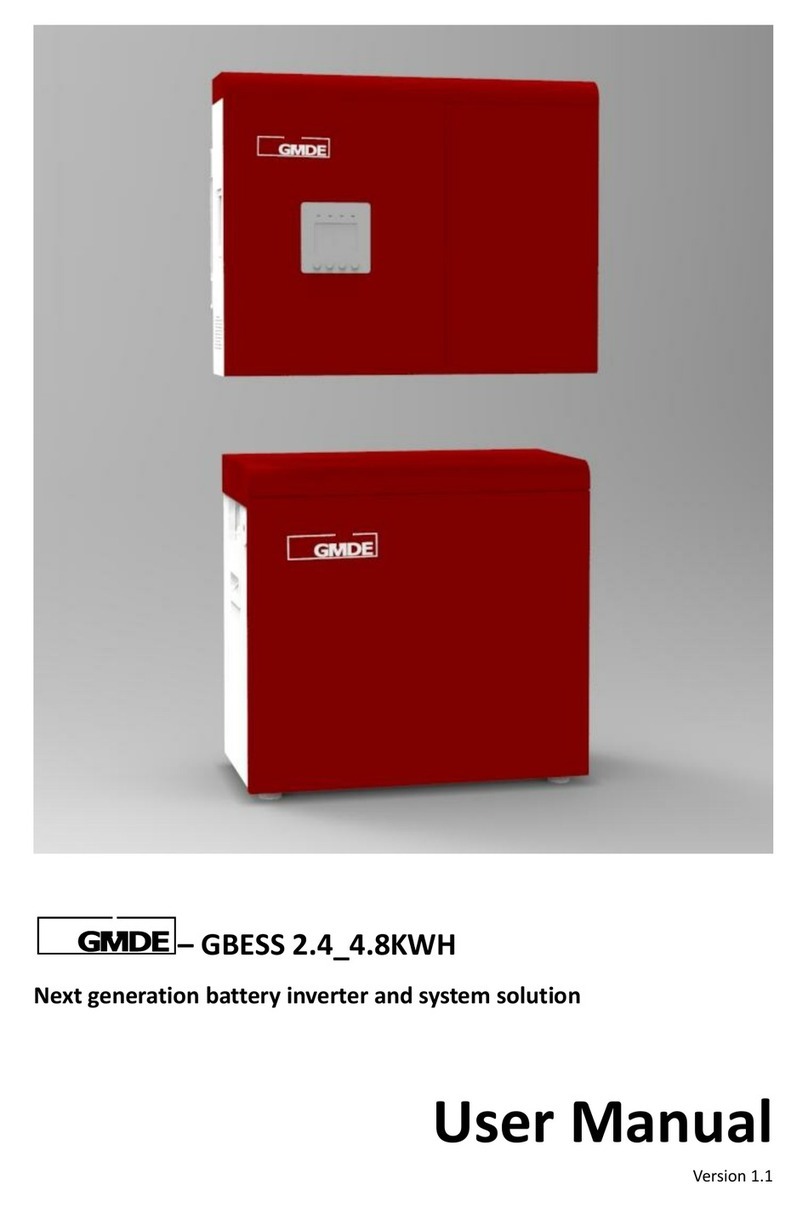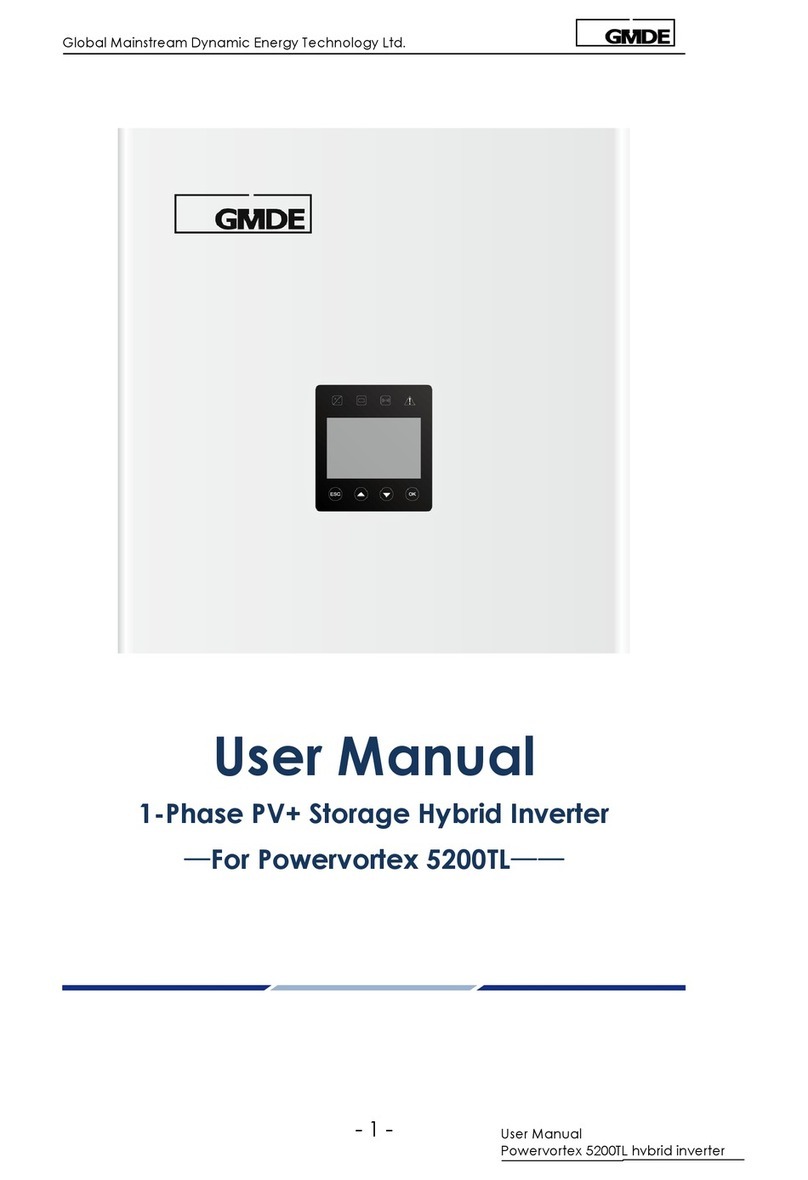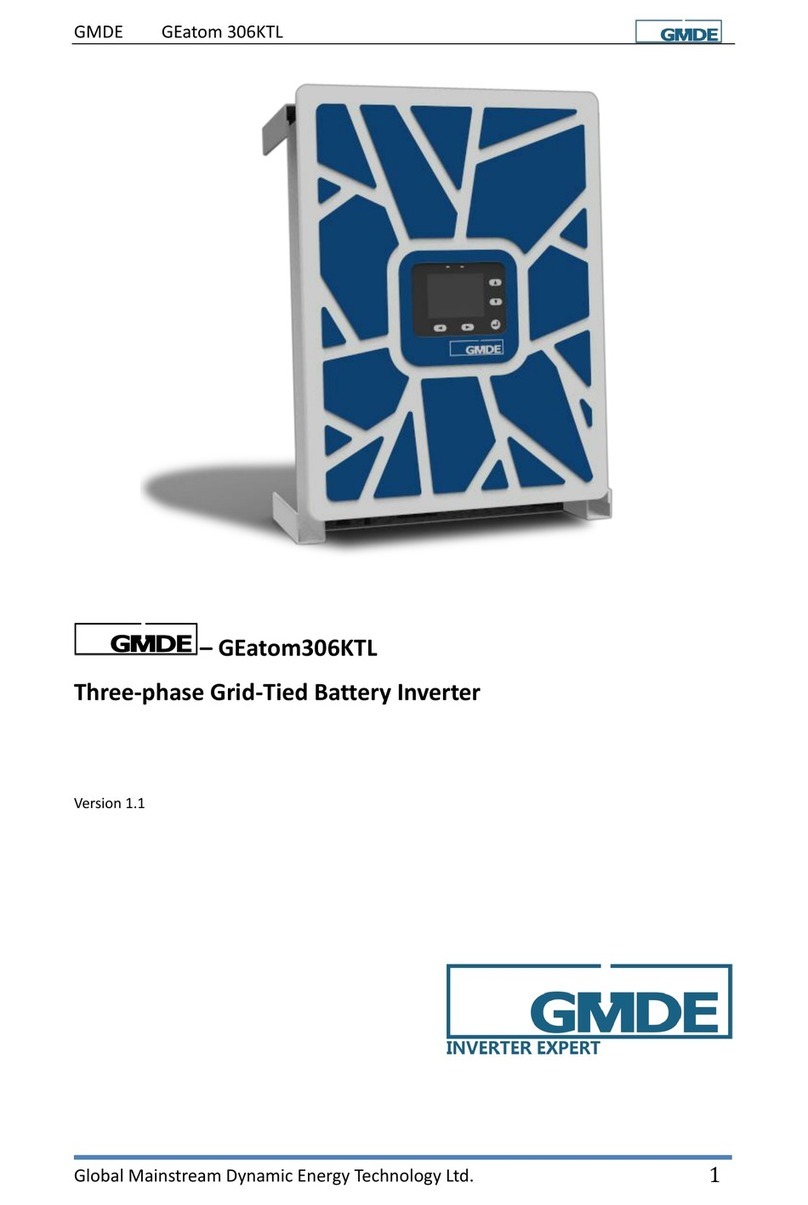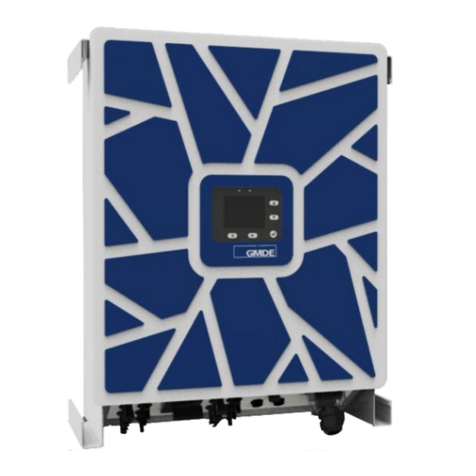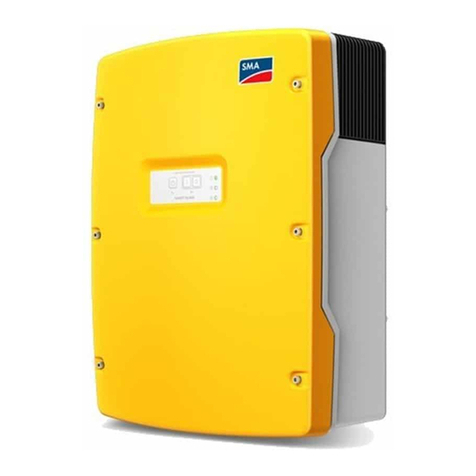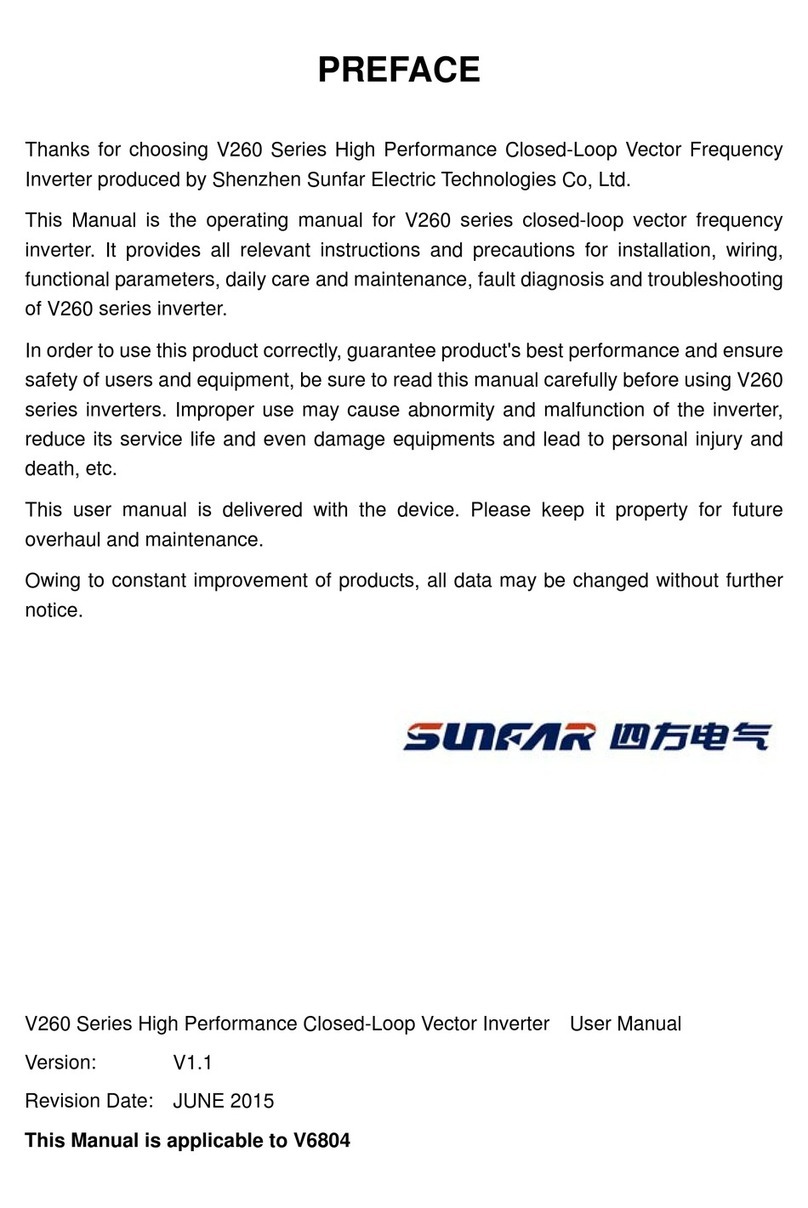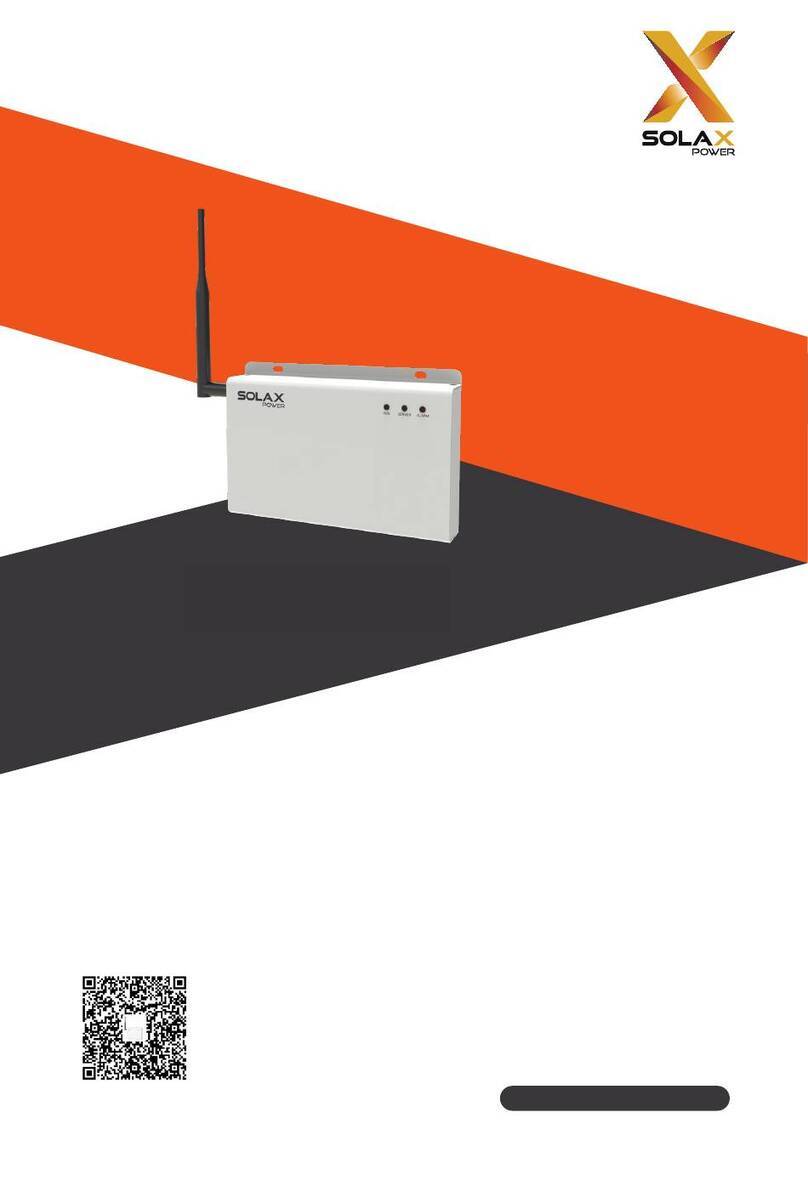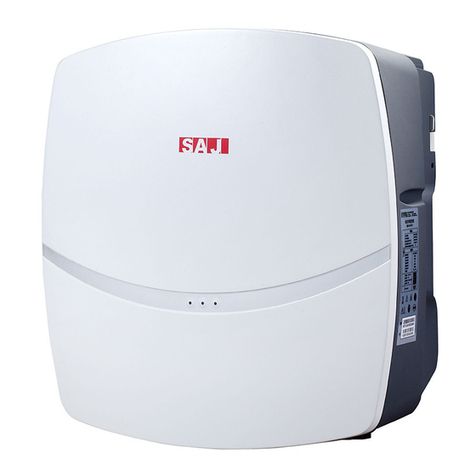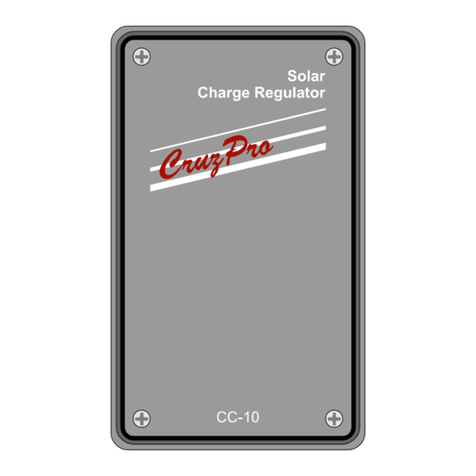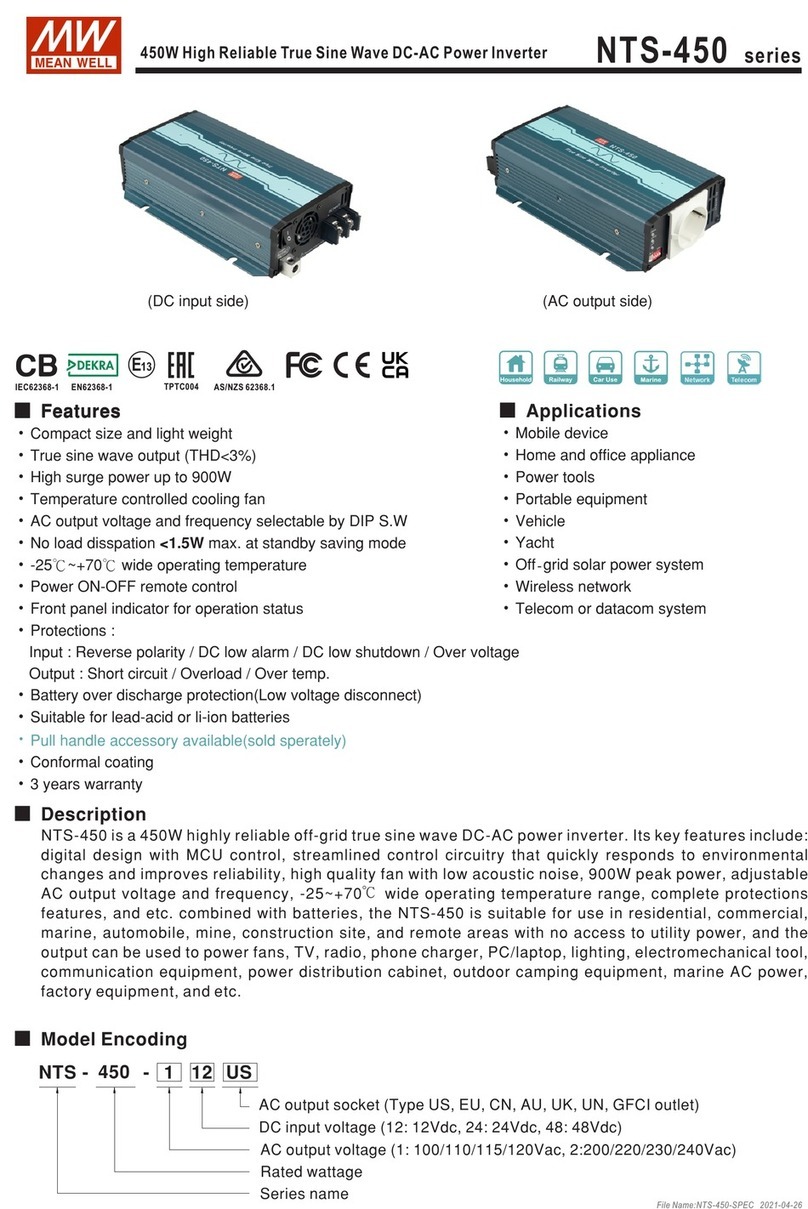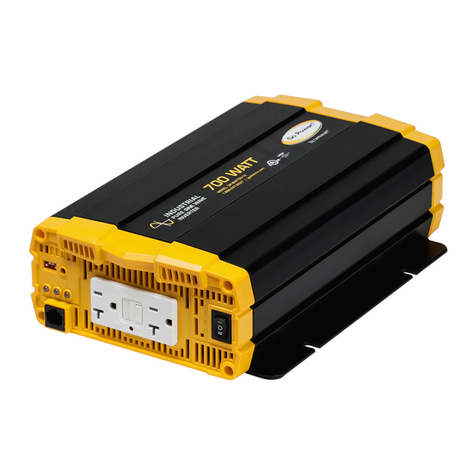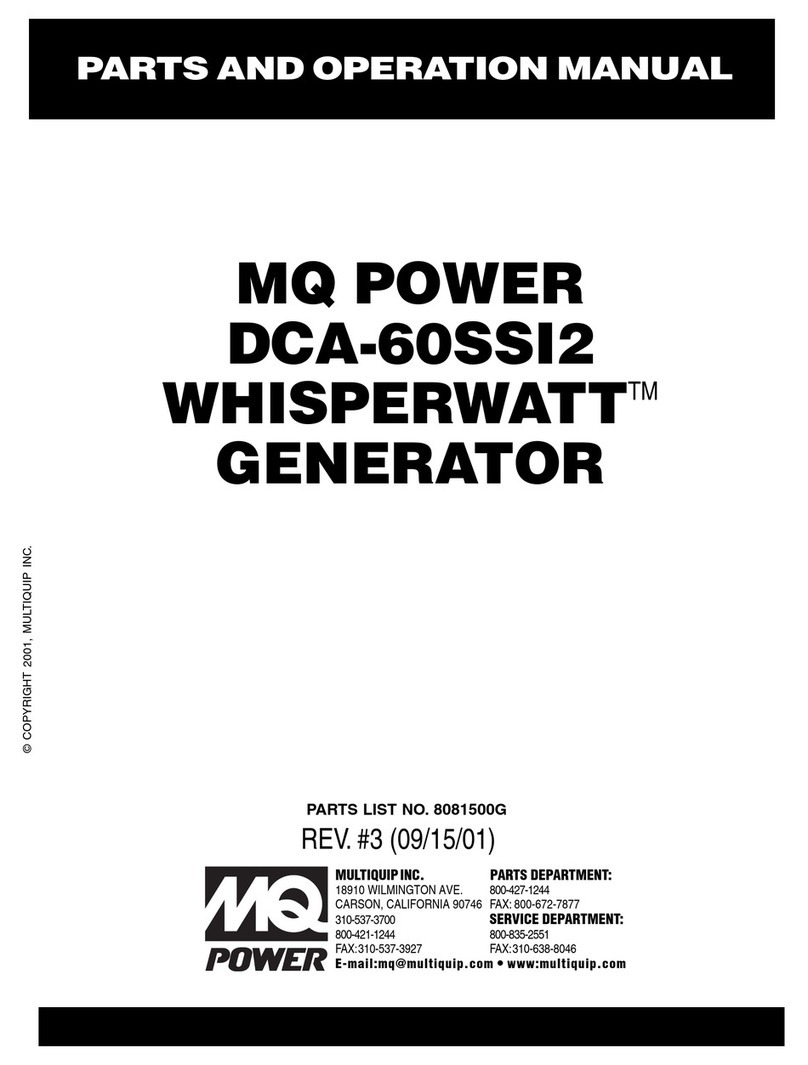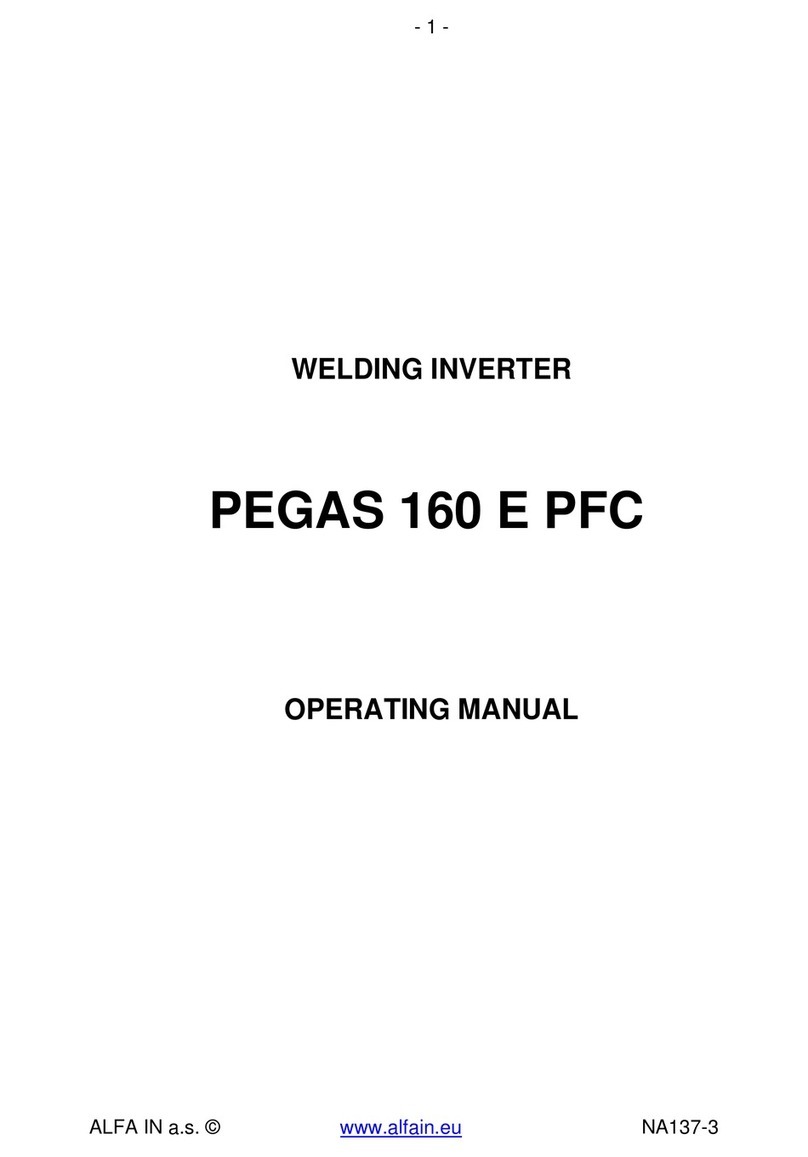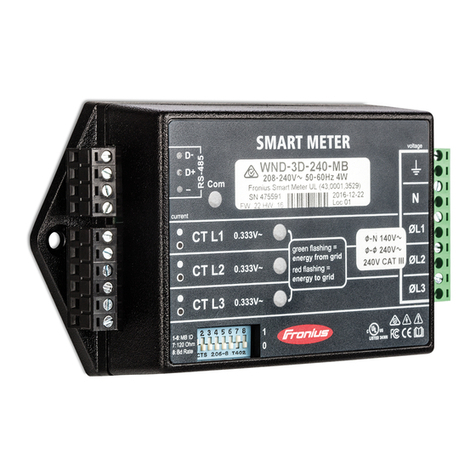GMDE GHESS 5.0_6.0KWH User guide

–GHESS 5.0_6.0KWH
GMDE 3-Phase Solar Battery Hybrid Storage System
Installation and Application Guide
Version 1.0

CONTENT
1. Unpacking and Packaging list ........................................................................................................3
2. System Overview...........................................................................................................................3
System Overview Diagram ................................................................................................3
System Specification..........................................................................................................4
2.1 Main System Components ..................................................................................................5
2.2 Internal Topology Illustration ..............................................................................................6
2.3 Output Connectors Illustration ...........................................................................................7
3. Installation.....................................................................................................................................7
3.1 Install the inverter ...............................................................................................................7
3.2 Install the battery packs ......................................................................................................8
3.3 External Line Connection ..................................................................................................11
4. System Operation........................................................................................................................13
4.1 System Start-Up.................................................................................................................13
4.2 System Interface................................................................................................................13
4.2.1 Main Operation Modes ..........................................................................................13
4.2.2 Operation Interface................................................................................................14
4.2.2 Change Operation Modes ......................................................................................15
4.3 System Turn-off .................................................................................................................17
5. Trouble Shooting .........................................................................................................................18
5.1 Fault Messages and Action List .........................................................................................18
5.2 Fault Acknowledgement....................................................................................................20
5.3 Technical Service ...............................................................................................................20

1. Unpacking and Packaging list
Before installation, please unpack the system packages and check if all the system components
are available according to list below. Or should any components listed below are damaged during
transport, please contact your seller or the supplier GMDE.
Packaging List
System Component
1.
Hybrid Inverter Powervortex 305KTL
1 PCS
2
GMDE 19”System Cabinet (with EMS unit, On/Off-grid switching box,
Battery Control Box 150V integrated, energy meter included )
1 PCS
3
Battery Module M15020
2 PCS
Document
4
User Manual
1 PCS
Table 1 Packaging List
2. System Overview
This manual describes the installation and operation of the GHESS series solar battery hybrid
energy storage system (HESS). The GHESS series hybrid energy storage system is designed and
developed by GMDE Technology Ltd. and can be widely used in residential applications. In which,
the GHESS 5.0_6.0kWh refers to a solar battery hybrid system with 5.0kW nominal AC output
power and 6.0kWh lithium-ion battery capacity. As the battery module adopted in this system is
150V20Ah cell, this system is battery capacity extendable with each step 3kWh (150V20Ah).
System Overview Diagram
Figure 1 is an overview diagram when installing the GHESS system and connecting it with Grid
and Load.

Figure 1 System Overview Diagram
System Specification
Table 2 is the brief spec of the GHESS 5.0_6.0kWh solar battery hybrid energy storage system.
MODEL
GHESS 5.0_6.0kWh
System parameters
Nominal/useable capacity[kWh]
6.0/4.80@80%DoD
Installation
All-in-one cabinet
Warranty [year]
5 years standard, battery 10 years extendable
PV side input
Max. input power [kW]
5.0
MPPT voltage range[V]
280-800
MPPT tracker
1
Battery side input
Operating voltage range[V]
150@[120, 500]
Max. charging power[kW]
4.0
Max. charging current [A]
18
Charging/discharging efficiency
96.5%/96.5%
AC output-on grid
Max. output power[kW]
5.0
Output voltage range[V]
3N~400, 324-436, 437-460(<10min.)
Certification
VDE-AR-N4105, IEC62109
AC output-off grid (Optional)
Rated voltage & frequency [V/Hz]
400±2%,50±2%
Output power [kW]
Rated power 2.5, instantaneous power 5.0
Power factor
[-0.7, +0.7]
Battery packs
The lithium iron phosphate battery pack
Nominal capacity [kWh]
6.0
Public Grid
M
Utility Meter
(Existed)
Meter
Load
Emergency
Load
PVMeter
AC GRID AC LOAD

Module/unit
150V/20Ah lithium-ion module*2 modules in parallel
Life cycle
80% DOD for 3000 life cycles
Visual interface
EMS
EMS
7 inch color touch screen
Interface communication
RS485/RS232/USB/Ethernet/Wifi
Table 2 GHESS 5.0_6.0kWh system specification
2.1 Main System Components
Viewing from outside, you’ll see the system is consisted of the main parts below:
Figure 2 Main System Components
Illustration:
1
Energy Management System(EMS) unit
2
System Circuit Breakers(AC GRID/ Emergency Load/PV/BAT)
3
Battery Control Box 150V
4
Battery Modules 150V20Ah
5
Hybrid Inverter 5kW
6
System Cabinet
7
Output Connectors
Table 3 System components list

2.2 Internal Topology Illustration
Figure 3 is the internal electrical topology of the system. The main functional components
contained in this system are:
Figure 3 Internal system topology
Component
Function
Hybrid inverter
To transfer the DC current generated by PV panel into AC current
and to charge/discharge the battery packs
On/off-grid Auto-switching
box
To switch the system from grid-tied to off-grid operation mode
when grid failure happens
Energy Management System
To monitor and control the system operation
Battery packs (including
Battery Control Box)
To store the energy generated by PV panels or from the public
grid
Energy meter
AC data collection and transportation
Table 4 Main function components
PowerVortex 305
Hybrid Inverter
GMDE On/Off Grid Auto-
Switching Box
Energy Management
System
BAT+
BAT- PV+
PV-
RS485CAN
COM
RS485
PV Meter
AC GRID AC LOAD
+ - L1 L2 L3 N L1 L2 L3 N PE PE
PIN8
PIN7

2.3 Output Connectors Illustration
Viewing from the back side of the cabinet, at the bottom of the cabinet, you can find the output
connectors, as shown in Figure 4.
Figure 4 Output connectors
3. Installation
The system is very easy to install. Insert the battery modules and hybrid inverter into the system
cabinet according to the following steps in Section 3.2 Install the battery packs and Section 3.1
Install the inverter; finish the output line connection according to Section 3.3 External Line
Connection; check and then the system installation is done.
3.1 Install the inverter
Please follow these steps to install the inverter into the system cabinet:
1) Align with wall bracket, move Powervortex 305KTL hybrid inverter in horizontal direction to
proper position;

2) Make the hook on wall bracket insert into the hole on the back of Powervortex 305KTL hybrid
inverter;
3) Slowly lower the hybrid inverter , ensure the device hang on the hook of wall bracket;
4) Check if the hybrid inverter is properly fixed on the wall.
Figure 5 Inverter installation
3.2 Install the battery packs
5) Insert the battery modules into the system cabinet, as shown in Figure 6;

Figure 6 Battery installation
2) At the back side of the cabinet, connect the hybrid inverter, Battery Control Box and battery
modules with the lines as shown in Figure 7; the detailed DC line connection between inverter
and battery packs are illustrated in Figure 8. (The battery packs are connected in parallel, which
means the final battery pack equals to 150V/40Ah)

Figure 7 Battery line connection

Figure 8 Detailed DC line connection on battery side
3.3 External Line Connection
Connecting the PV panels, public grid, AC load and meter with the systems with this system via
the following output connectors, as shown in Figure 9.

Figure 9 External Line Connection
PowerVortex 305
Hybrid Inverter
GMDE On/Off Grid Auto-
Switching Box
Energy Management
System
BAT+
BAT- PV+
PV-
RS485CAN
COM
RS485
PV Meter
AC GRID AC LOAD
+ - L1 L2 L3 N L1 L2 L3 N PE PE
PIN8
PIN7

4. System Operation
4.1 System Start-Up
To start up:
1) Turn on the circuit breaker ”AC Grid”(QF1);
2) Turn on circuit breaker “BAT”(QF12); now the EMS is powering on and the battery packs is
connecting with inverter;
3) Turn on circuit breaker “PV”(QF11), to connect the PV panel on the hybrid inverter;
4) Turn on circuit breaker “LOAD”(QF2), to connect the emergency load on the hybrid inverter.
4.2 System Interface
4.2.1 Main Operation Modes
When the system is connected with the public grid, the GHESS series solar battery hybrid system
has 2 operation modes: Self-use mode and Peaking Shaving mode. When outages, the system can
also operate under back up mode, in which the grid is disconnected and emergency load power is
supplied by the system independently.
Below is introduction on the 3 operation models:
1. When the grid is normal:
1) Self-use mode: the GHESS series solar battery hybrid system can increase the PV Self-use up
to 75%
Daytime: If there is enough sunshine, energy generated by PV supplies the load first and then
charges battery packs; if the load power is covered and battery is full charged, surplus energy
will be fed into the public grid to win the FIT tariff;
Night or no enough sunshine: the hybrid system first discharges the battery pack to cover the
load; if the energy is still not sufficient, the grid will power the rest family load.
Note: The system has finished initial setting and configuration before leaving factory. So during the
installation and operation process, it is not suggested for installer/customer to change the default
settings and internal wiring, as this will void the warranty. If there are any special requirements
needed, please contact your seller for support.

2) Peak Shaving mode: save energy bill via shifting energy from peak time to off-peak time for
areas with Time of Use electricity prices.
After setting the charging and discharging time via the touch screen, the system can charge the
battery packs during the off-peak time(charging time) and discharge the battery during the
peak time (discharging time), which realize peak shaving based on different electricity prices.
2. When the grid is failed or abnormal:
3) Back Up mode: disconnect from the public grid and emergency load power is supplied by
the system independently.
Auto-switch to off grid: it has device has integrated backup function. So when the device
sensors the drop/change of the grid voltage, it disconnects the relay completely and then shifts
from on-grid to off-grid mode. Under the off-grid mode, the important load is powered by
battery;
Auto-switch to on grid: When the device sensors that the grid is back to normal, it stops
running under off-grid mode and then closes it’s internal relay. The system is running under
on-grid mode again.
4.2.2 Operation Interface
The default operation mode for the system is Self Use mode. When starting the system, the EMS
touch screen enters the Home page as below:

Figure 10 Home page of EMS
Touch the other items (such as “Production”, “System”etc.) on the touch screen to shift between
different items.
4.2.2 Change Operation Modes
To change the system operation mode from default Self Use to Peak shaving, please follow below
steps:
1) Touch the “User”item on the touch screen and enter the “User”page.
Figure 11 User page on the EMS

2) Touch the “Setup”button on the right and bottom of the “User”page, then input the
password to login. The default password is 666666.
Figure 12 Input the password
3) On the “Setup”page below User page, touch the “System”button on the left side, and
change the System Mode options from Self Use to Peak Shaving.
Figure 13 Operation modes selection

4) After choosing the “Peak Shaving”mode, you also need to set the time range and power for
charging / discharging. Save the successful setting and the system will operate under peak
shaving mode.
Figure 14 Time range and power setting under Peak Shaving mode
4.3 System Turn-off
To turn off:
5) Turn off circuit breaker “BAT”(QF12);
6) Turn off circuit breaker “PV”(QF11);
7) Turn off the circuit breaker ”AC Grid”(QF1)
8) Turn off circuit breaker “LOAD”(QF2)
Note: the system will automatically shift to Backup operation mode when the public grid is
failed. There is no need for manual setting.

5. Trouble Shooting
5.1 Fault Messages and Action List
When failure occurs, warning codes will be displayed on the touch screen. The latest 20 fault
codes will be stored in the EEPROM. Check the history fault information via the touch screen.
Detailed fault definitions are listed as below:
Item
Fault Message
Action List
1
Offset Iac Warning
Re-start the system and if not released, contact your seller for
service support.
2
ENS Mess Warning
Re-start the system and if not released, contact your seller for
service support.
3
ENS GFCI Warning
Re-start the system and if not released, contact your seller for
service support.
4
AC Sensor Warning
Re-start the system and if not released, contact your seller for
service support.
5
Inverter Curr
Warning
Re-start the system and if not released, contact your seller for
service support.
6
GFCI Warning
Re-start the system and if not released, contact your seller for
service support.
7
GFCI Device Warning
Re-start the system and if not released, contact your seller for
service support.
8
Zpv PE Warning
Re-start the system and if not released, contact your seller for
service support.
9
Rly Warning
Re-start the system and if not released, contact your seller for
service support.
10
Vac Warning
Re-start the system and if not released, contact your seller for
service support.
11
Fac Warning
Re-start the system and if not released, contact your seller for
service support.
12
External Comm
Warning
Re-start the system and if not released, contact your seller for
service support.
13
No Utility
Re-start the system and if not released, contact your seller for
service support.
14
VdcMax Warning
Re-start the system and if not released, contact your seller for
service support.
15
Master Slave
Warning
Re-start the system and if not released, contact your seller for
service support.
16
Temperature
Warning
Re-start the system and if not released, contact your seller for
service support.

17
ENS Vac Warning
Re-start the system and if not released, contact your seller for
service support.
18
ENS DCI Warning
Re-start the system and if not released, contact your seller for
service support.
19
Bat High Warning
Re-start the system and if not released, contact your seller for
service support.
20
Boost Start Warning
Re-start the system and if not released, contact your seller for
service support.
21
BUS Low Warning
Re-start the system and if not released, contact your seller for
service support.
22
BUS High Warning
Re-start the system and if not released, contact your seller for
service support.
23
ENS Fac Warning
Re-start the system and if not released, contact your seller for
service support.
24
Boost Curr Warning
Re-start the system and if not released, contact your seller for
service support.
25
PV Connect Warning
Re-start the system and if not released, contact your seller for
service support.
26
DC Over Power
Re-start the system and if not released, contact your seller for
service support.
27
FanLock Warning
Re-start the system and if not released, contact your seller for
service support.
28
EEPROM Warning
Re-start the system and if not released, contact your seller for
service support.
29
GFCI Device Fail
Re-start the system and if not released, contact your seller for
service support.
30
Curr sensor Fail
Re-start the system and if not released, contact your seller for
service support.
31
Inverter Curr Fail
Re-start the system and if not released, contact your seller for
service support.
32
PV Conenect Fail
Re-start the system and if not released, contact your seller for
service support.
33
Bus low Fail
Re-start the system and if not released, contact your seller for
service support.
34
Bus high Fail
Re-start the system and if not released, contact your seller for
service support.
35
ENS Fail
Re-start the system and if not released, contact your seller for
service support.
36
M-S Version Fail
Re-start the system and if not released, contact your seller for
service support.
37
Ias DCI Fail
Re-start the system and if not released, contact your seller for
service support.
38
Rly Fail
Re-start the system and if not released, contact your seller for
service support.

5.2 Fault Acknowledgement
After shutdown due to a fault, the device remains locked against reactivation until the fault is
acknowledged. The fault can only be acknowledged after the cause of the fault has been
eliminated.
To acknowledge the fault messages, press the ESC key or turn the GMDE inverter off with the DC
switch. Wait for a while and turn the device on again.
5.3 Technical Service
GMDE
Room 604-605, Tongpu Road No.1220, Putuo District, Shanghai 200333, P.R. China
TEL: +86 21 60710809-818
FAX: +86 21 61730300
E-mail: Service@global-mde.com
WEB: www.global-mde.com
SKYPE: GMDE Service
Table of contents
Other GMDE Inverter manuals
Popular Inverter manuals by other brands

SCOV
SCOV SV800 Series user manual

Sandi Electric
Sandi Electric SDP-30KW User and installation manual
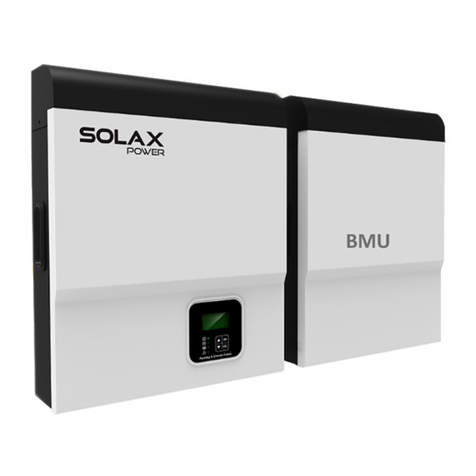
SolaX Power
SolaX Power X-Hybrid SK-BMU Quick installation guide
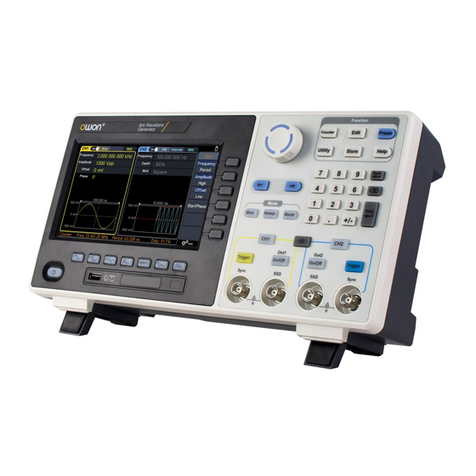
Owon
Owon XDG2000 Series manual
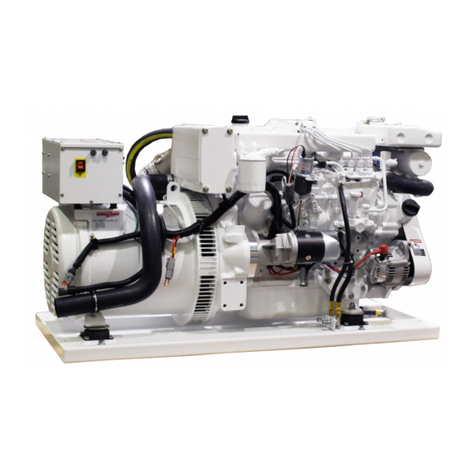
Northern Lights
Northern Lights M864W and M864W3 Operator's manual

Mitsubishi Electric
Mitsubishi Electric FR-D700 Series instruction manual
